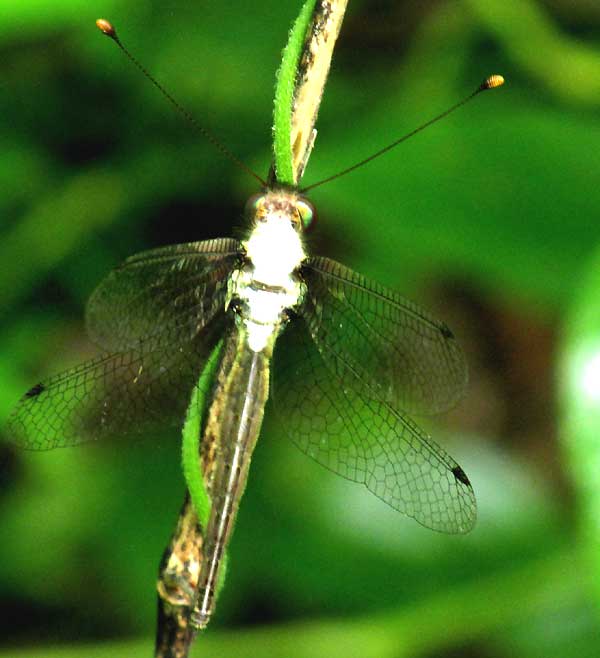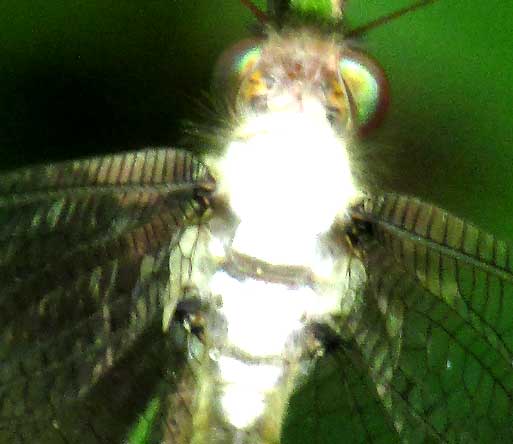Excerpts from Jim Conrad's
Naturalist Newsletter
from the June 2, 2007 Newsletter issued from Sierra Gorda Biosphere Reserve, QUERÉTARO, MÉXICO
OWL FLY BENEATH THE LIGHT
 Early one recent morning, beneath a high-efficiency security lamp mounted on one of my casita's outside walls, clinging to the white stucco I found the strange, dragonfly-size, dragonfly-like insect shown at the right.
Early one recent morning, beneath a high-efficiency security lamp mounted on one of my casita's outside walls, clinging to the white stucco I found the strange, dragonfly-size, dragonfly-like insect shown at the right.
But of course no dragonfly bears such long antennae as the creature in that picture. The antennae alone prove that it's not a dragonfly. In fact, it doesn't even belong to the same ORDER as dragonflies, which means that it's approximately as unrelated to dragonflies as a sparrow is to a woodpecker -- different orders.
I wouldn't have known what my wall-percher was if I hadn't found a larva of this kind of insect when I lived near Sandy Creek in Mississippi, writing about it under the heading "Little Dragon with Big Pincers" in my September 5th, 2004 Newsletter. You can see a scanning of that small but mean-looking larva at www.backyardnature.net/pix/owlflylv.jpg.
My wall-percher was an owlfly, closely related to the antlions whose sharp-pincered larvae, often called doodlebugs, dig conical pits in sand and dust, position themselves beneath the sand at the pit's bottom, and await prey who tumble into the pit. That's different from owlfly larvae, though, who with their large jaws roam around hunting prey on the ground and in low vegetation.
Adult owlflies feed on other flying insects. I read that when they're disturbed they release a strong, musk-like chemical that deters enemies, but I didn't harass my wall-percher so I didn't notice that. It's assumed that by poking their abdomens into the air when they're perching their enemies may confuse them with broken twigs.
That strategy sure doesn't work, however, when they're resting on a white stucco wall.
issued on August 13, 2019 from near Tepakán, Yucatán, MÉXICO
OWL FLY WITH A WHITE, FUZZY THORAX
In early morning after a heavy rain the previous afternoon and showers all through the night, I was walking down a dark, drippy trail tunneling through tall vegetation, when a small patch of whiteness detached from the trail and unhurriedly drifted up and away. When it settled a few feet beyond, it looked like a particularly dainty kind of dragonfly, not holding its four wings right to be a damselfly. In the shadowy tunnel I was lucky to manage the photo shown below:

But, I'd never a dragonfly with such a white patch, plus -- when I finally noticed it -- it couldn't be a dragonfly because dragonflies and damselflies bear short antennae. It was an owlfly, and even for an owlfly that white patch didn't look right. A closer view is provided below:

The white fuzziness doesn't restrict itself to the thorax, but rather extends onto the head and abdomen. I think that the poor owlfly is badly infected with a fungus, which might be explained by the current series of daily rains, high humidity and intense heat. It's fungusy weather.
Owlflies belong to the same insect order -- the Neuroptera -- as antlions, but a different family, the Owlfly Family known as the Ascalaphidae. According to a 2014 work by Atilano Contreras-Ramos and María Rosas, entitled "Biodiversidad de Neuroptera en México (Revista Mexicana de Biodiversidad, Supl. 85), freely downloadable in PDF format, 21 owlfly species can be found in Mexico -- 430 species worldwide.
Interestingly, the New World species of owlfly tend to be most active at dawn and dusk, while Old World speies often are most active during the day.